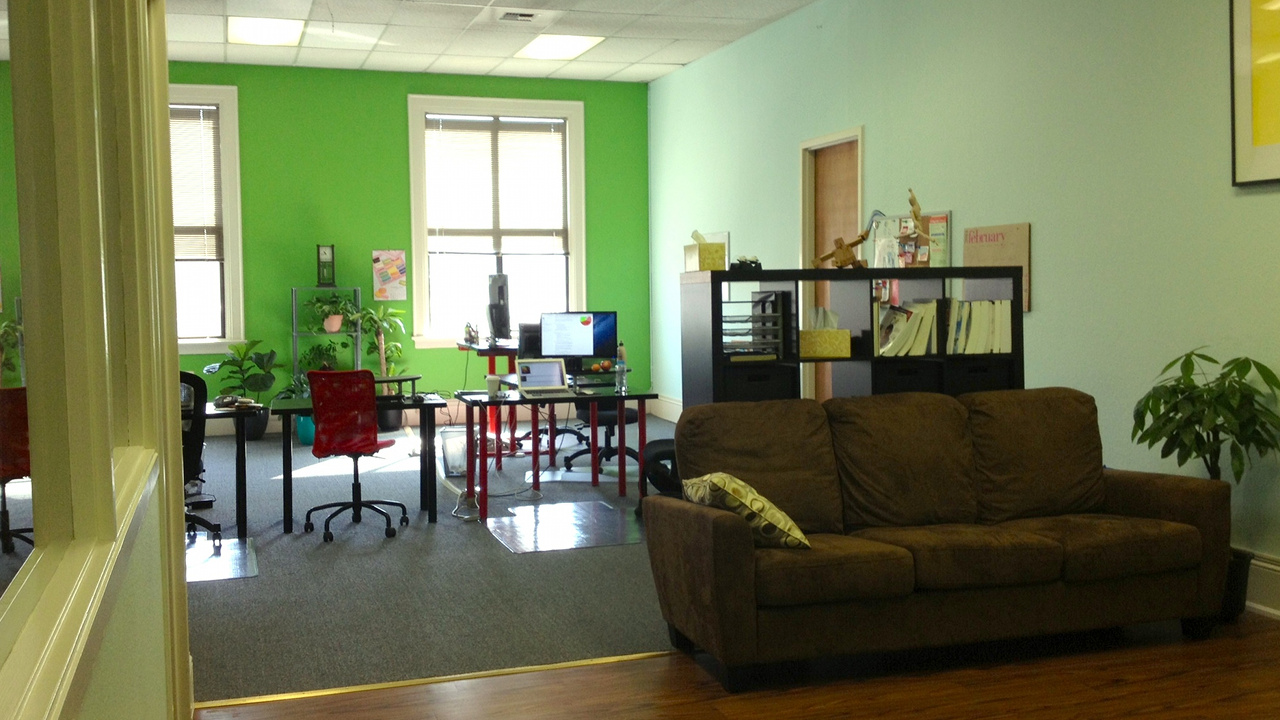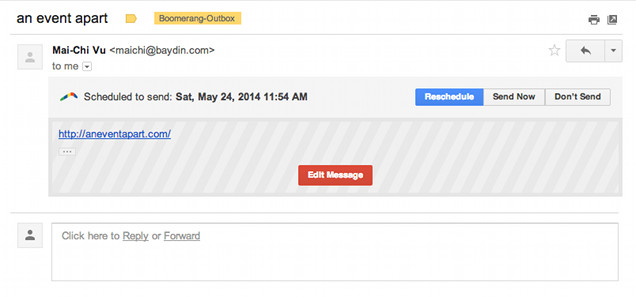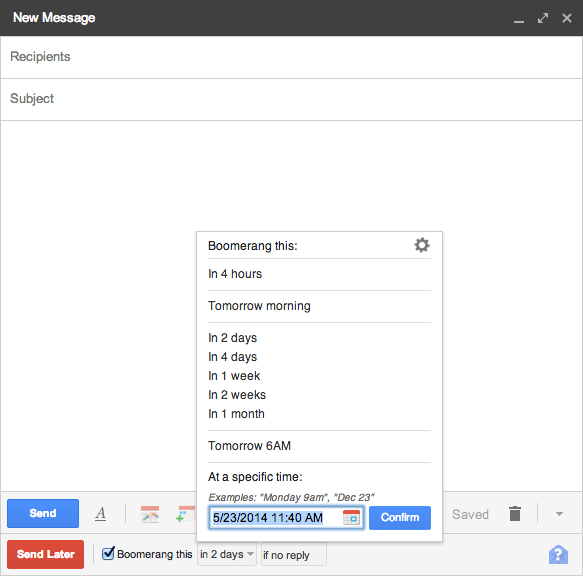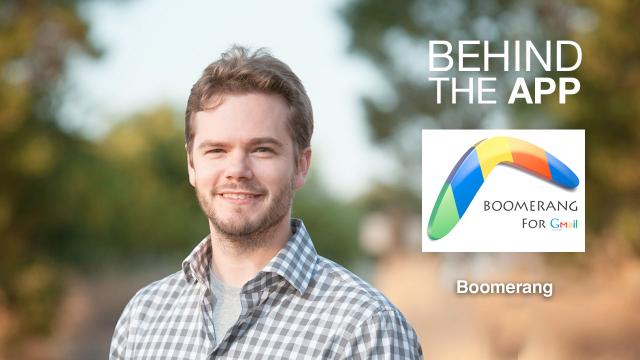Boomerang is like an email magic trick. The plugin lets you schedule emails to be sent whenever you’d like, hide messages for later (like hitting a snooze button), and it has a number of other useful abilities to ease your inbox woes.
We’ve talked about it before. If you follow our How I Work interviews, then you might have noticed that Boomerang is often mentioned by CEOs, editors and founders as an essential tool. How did this email tool come about? We spoke with Baydin CEO Alexander Moore to learn the history of Boomerang.
Where did the idea for Boomerang come from? Were you trying to solve a problem you’d experienced, or did the inspiration come from somewhere else?
Like so many of my favourite apps, the idea for Boomerang came from personal pain. While I was working on HDTV switches at Analogue Devices, I became a project team lead. Instead of spending my time working with boards and oscilloscopes, I started spending entire days in Outlook keeping track of deadlines and managing processes.
The biggest problem was keeping track of messages that I couldn’t do anything with today, but that needed attention later. Samples that needed to ship on Thursday. Tests that needed to be run on Friday. And so on.
I tried a follow-up folder, flags, just leaving messages in my Inbox, an insanely complicated several-dozen-folder system, and more. Nothing was easy and functional enough to use, so important emails still fell through the cracks.
I wanted a way to have a message come back when it was relevant without me having to think about it or keep it banging around in the back of my mind. What I wanted was Boomerang!

After you came up with the idea, what was the next step?
We started building.
These days, you’re not supposed to talk about writing code before talking to customers. But nobody had built anything like Boomerang before, so it wasn’t easy to explain how powerful such a simple concept could be without letting people try it.
So we spent three months furiously writing code. We knew that we were solving a real problem for ourselves, and that gave us the confidence to go ahead and build a simple version of the product.
Even before it was fully functional, we started using it ourselves every day. We iterated and improved and kept sanding down the roughest edges. It kept getting better, and we found ourselves depending on it and trusting it more and more. As soon as we thought we had something just barely workable, we let it loose into the world.
Once we had our product in the hands of users and could see how they used it, we knew we were on to something. We were able to take advantage of our user feedback to make the product better at an even faster clip.
How did you choose which platforms to target and which to ignore or wait on?
Our first prototypes were on Microsoft Outlook, because it had a development platform and because most business users are on Outlook. But we were all using Gmail, so our prototypes didn’t solve the problem for ourselves. And that was the whole point!
As quickly as we could learn how, we started building Boomerang on top of Gmail. Then, we could use it ourselves, and all of our friends and fellow startup founders could use it too. After we launched, the reception for our Gmail product was so strong that we knew we should continue to focus our efforts there.
The other path we considered was building our own desktop email client instead of building plugins for other mail systems. Unfortunately, it takes months of development work just to build a desktop mail client that has a full enough feature set to be someone’s primary mail client — even before you add anything new!
Mobile wasn’t even an option for us. In 2010, Apple did not approve apps that competed with native functionality, so Gmail itself didn’t even have a native app yet!

What was your biggest roadblock and how did you overcome it?
The biggest roadblock for us was charging for our software. We were worried that we had created a very useful tool, and that we would be able to get lots of passionate users, but we might not be able to build a business on top of it. Compounding the problem, when we were raising our seed round, almost everyone told us that we’d never be able to charge for an email plugin. Fortunately, they were all wrong!
We figured out how to charge through a series of low-fidelity, quick tests that brought us closer and closer to our ultimate business model.
First, we added a “buy a subscription” button to the homepage. People who clicked the button went to a form where they could pay whatever they thought was fair for a one-year subscription to the service. Almost 1% of our new users voluntarily chose to subscribe, so at that point, we knew people would pay for the service.
Next, we looked at the histogram of the name-your-own-price data and updated the voluntary subscription page to include different price points that looked promising. Then, we used that data to set our final prices and emailed the user base with a one-time, 24 hour coupon. At the end of that day, we knew Boomerang could be a successful business.
What was launch like for you?
Completely crazy! We reached out via Twitter to get our first article, and Boomerang took off like wildfire from there. Lifehacker alone sent 20,000 people to our site in two days. We barely slept, fixing bugs and adding new features as fast as we possibly could.
We wrote a detailed post about a month after our launch describing the process and what we learned.
How do you handle user requests and criticisms effectively?

The best advice we’ve gotten about handling customer requests is that the feedback almost always reveals real user needs and real user pain. So even though the customer’s suggested feature or suggested implementation may not make sense, we think a lot about how we can address the underlying need in a way that does.
We also keep detailed notes on how often we get each feature request. We use that data, along with detailed analytics data about how people are using the product, to shape about two thirds of our product roadmap. The other third of our resources, we get to spend on crazy ideas!
Criticism is harder to manage. From a company perspective, we respond to every single email, no matter how grumpy. About half the time, just sending a personal note transforms the entire relationship. If it doesn’t, we do our best to let it roll off our backs.
Managing criticism from a founder perspective is hard too. After a certain point, founders should stop handling customer support, because everything is too personal. These days, I set aside a specific block of time to read customer emails every week. The rest of the time, I filter them out of my Inbox.
Now, how do you split time between developing new features and managing existing ones?
In general, we always try to prioritise via asking ourselves “what is our one biggest problem right now?” When Google makes changes to the Gmail interface and Boomerang needs to update to address them, the answer’s really easy!
Other times, the solution is not as clear. A few months after we released Boomerang, our analytics data showed that lots of users had figured out our Send Later feature, but they didn’t fully understand how to use the Boomerang (snooze an email) feature or why they’d want it. Getting users to start using Boomerang showed up as the biggest improvement we could make.
We designed and built a feature we call “magic” to help — we automatically find dates in email bodies and suggest returning the message at the relevant time. If you’re travelling in six months, we’ll suggest bringing the airline confirmation code message back the morning you need to check in. Once users snoozed a couple messages that way, they started to understand how Boomerang could change their entire relationship with email.
When our biggest problem is adding more value to the product, that’s when we get to build new stuff!
Aw, the Baydin team two years ago! #TBT pic.twitter.com/Yogi2eWQnb
— Baydin Inc (@baydin) August 8, 2013
What advice would you give to others that want to take on a similar project?
Just get started! Nobody knows that much more than you do; we’re all just learning as we go. As long as you’re motivated, thoughtful, and get good people involved, you can figure the rest out.
Oh, and ship! Ship internally (dogfood), use your own stuff and keep making it better. When it’s just barely acceptable, ship externally. Until you ship, and see how real users interact with your product, you’ll never know what you have!
Lifehacker’s Behind the App series gives an inside look at how some of our favourite apps came to be — from idea to launch (and beyond).

Comments
One response to “Behind The App: The Story Of Boomerang”
I upgraded to the paid version of Boomerang just yesterday. I absolutely love it.